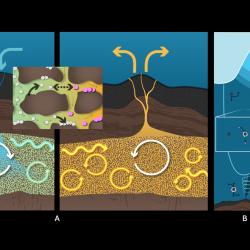Astronomers Discover Mysterious Milky Way Object That Emits Radio Waves and X-rays
Zorawar Wadiasingh, a visiting assistant research scientist at the University of Maryland, helped predict and interpret this new cosmic phenomenon.
An international team of astronomers discovered a new cosmic phenomenon in the Milky Way: an object about 15,000 light-years from Earth that emits pulses of radio waves and X-rays for two minutes every 44 minutes.

The study, led by the International Centre for Radio Astronomy Research (ICRAR) and published in the journal Nature, documents the first time an object belonging to a recently discovered astronomical class called long-period radio transients (LPTs) has been detected in X-rays.
ICRAR researchers first detected LPTs—objects that periodically emit radio pulses minutes or hours apart—in 2022. Ten LPTs have been discovered since then, but until now they have only been detected in radio waves, which are much lower energy than X-rays.
Researchers from ICRAR and institutions around the world found this latest mysterious object, dubbed ASKAP J1832-0911, while using ASKAP, a radio telescope owned by Australia’s national science agency. NASA’s Chandra X-ray Observatory happened to be observing the same swath of sky at the same time, revealing that the radio signals and X-ray pulses were emanating from a single source.
“Discovering that ASKAP J1832-0911 was emitting X-rays felt like finding a needle in a haystack,” said the study’s lead author Ziteng (Andy) Wang from Curtin University and the ICRAR. “The ASKAP radio telescope has a wide field view of the night sky, while Chandra observes only a fraction of it. So, it was fortunate that Chandra observed the same area of the night sky at the same time.”
Study co-author Zorawar Wadiasingh, a NASA research scientist and visiting assistant research scientist in the University of Maryland’s Department of Astronomy, said the advent of new telescope technologies enabled this exceptional find.
“These objects, which are apparently common and extremely bright in the radio spectrum, could have been found 40 or 50 years ago if someone knew where to look, but only now do we have radio telescopes with the kind of software and computational techniques to really look for them,” Wadiasingh said. “Even now, the X-ray discovery is an extremely lucky event.”
Wadiasingh and some of his colleagues, including Paz Beniamini at the Open University of Israel, previously predicted the existence of extreme neutron stars called long-period magnetars that emit both X-rays and radio waves. While the pulses emanating from ASKAP J1832-0911 are characteristic of an LPT, what exactly the object is remains unknown.

“ASKAP J1831-0911 could be a magnetar—the core of a dead star with powerful magnetic fields—or it could be a pair of stars in a binary system where one of the two is a highly magnetized white dwarf, a low-mass star at the end of its evolution,” Wang said. “However, even those theories do not fully explain what we are observing. This discovery could indicate a new type of physics or new models of stellar evolution.”
Wadiasingh explained that collecting data on other sources of radio waves and X-rays could help characterize ASKAP J1831-0911 by ruling out possibilities. He believes that future, better equipped telescopes will be able to find even more of these objects and cited the Advanced X-ray Imaging Satellite (AXIS), a proposed NASA mission spearheaded by UMD Astronomy Professor Christopher Reynolds, as one example. If selected, AXIS would be 10 times more sensitive to X-rays than Chandra was at its launch in 1999.
“AXIS could follow up on these radio discoveries better than Chandra can because it’s more sensitive and has a wider field of view, so it would be a generational leap,” Wadiasingh said. “By the end of the decade, astronomers will find lots more of these objects—perhaps dozens or even hundreds.”
###
This article was adapted from text provided by the International Centre for Radio Astronomy Research.
The paper, “Detection of X-ray emission from a bright long-period radio transient,” was published on May 28, 2025, in Nature.
This research was supported by the European Research Council (Grant No. 817661), the Proof of Concept “DeepSpacePulse” (No. 101189496), a Catalan grant (No. SGR2021-01269), the program Unidad de Excelencia Maria de Maeztu (No. CEX2020-001058-M), FARE for research in Italy (No. R20L5S39T9), the U.S. National Science Foundation (Award No. AST-1816492), NASA (Award Nos. 80GSFC21M0002, 80NSSC24K0770 and 80NSSC20M0124), the United States-Israel Binational Science Foundation (Grant No. 2020747), the Israel Science Foundation (Grant No. 1649/23), the Hintze Family Charitable Foundation, the U.S. Naval Research Laboratory, the NRL Sustainment Restoration and Maintenance fund, the Australian Research Council (Nos. DP210102103, FT190100231, DE220100819, DP210102103, DP220102305, CE170100004 and CE230100016), the UK STFC (Grant No. ST/Y001117/1), the Inter-University Institute for Data Intensive Astronomy, the ARC Discovery Early Career Research Award (No. DE250100508), SAO (Grant No. GO3-24121X), the Severo Ochoa (Grant No. CEX2021-001131-S), a national grant funded by the MCIU/AEI (No. PID2023-147883NB-C21), the LSST-DA, the Brinson Foundation, the Moore Foundation, the Michigan Space Grant Consortium and the National Natural Science Foundation of China (Grant No. 12273009). This article does not necessarily reflect the views of these organizations.







